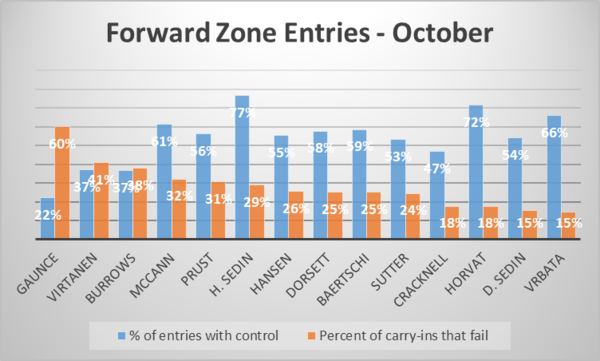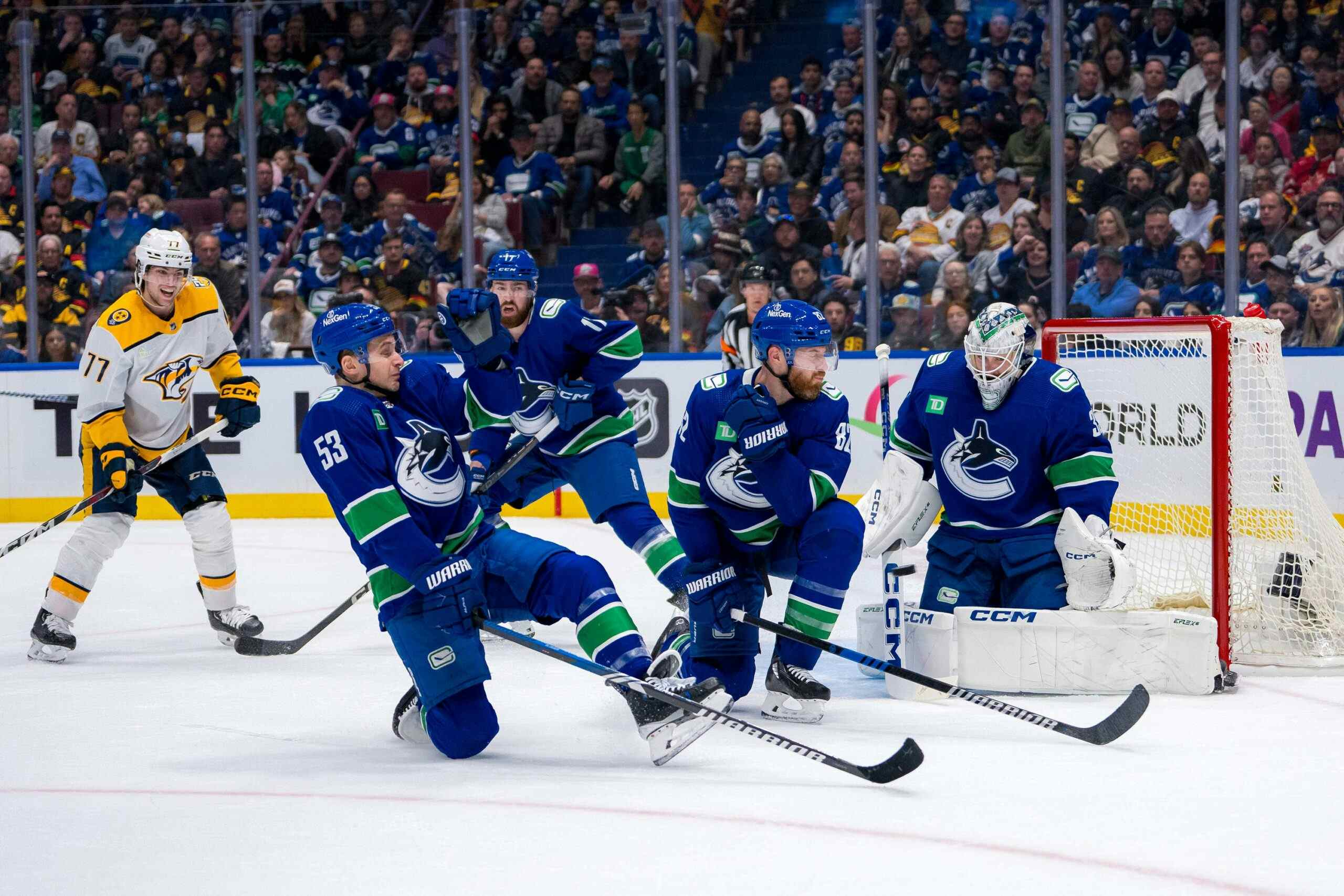Canucks October Deep Dive
By money puck
8 years agoIt’s been a unique October for the Vancouver Canucks. If you had told me back in August that they’d end the month with no less than four rookies in their lineup, Ryan Miller would be posting some of the best goaltending numbers in the league, and the Anaheim Ducks would be in the lead for the Auston Matthews sweepstakes, I would have been questioning the efficacy of your prescription medications, but here we are.
Let’s dig into the first month of the 2015-16 season after the jump.
The Competition
The Canucks exited October with a respectable 14 points (5 wins, 2 losses, and 4 OT losses). They benefited from a pretty sheltered schedule in the first month, with only 6 games against teams currently sitting in the playoff picture (Montreal (W), Washington (L), LA (W), Dallas (OTL), Arizona (W), St. Louis (L)).
November will get more challenging with 14 games on the slate, including a long 7 game Eastern Conference road trip.
The Goaltending
With Markstrom injured to start the season, it was up to Ryan Miller to carry the lions share of the starts for October, and he was superb. In fact, the .923 SV% he posted in October was his best start since the 2011-12 season (October 2011 SV% 0.930).

When assessing goalie performance, what we’re really looking to assess is how often your goalie put your team in a position to win. We can calculate that using quality starts, which is the percentage of the times the goalie posts a save percentage higher than the league average, which was 0.910 during October 2016:

As we can see, Miller posted a quality start 7 out of the 10 times so far this year, which is exactly what you hope to see from your starting goalie.
Goalie analytics have been advanced lately, with metrics like High Danger Save Percentage and Adjusted Save Percentage getting some love amongst the analytically inclined in the hockey community. From my perspective, the most interesting new goalie stat out there is Nick Mercadente’s Adjusted Goals Saved Above Average per 60 minutes. Basically, this stat calculates the average save percentage for goalies by danger area (high, medium and low danger) then calculates how many more, or less, goals the goaltender in question will save, per 60 minutes of ice time. The benefit of this stat is that it takes into consideration whether or not a goaltender faces easier or tougher shots behind their defense, versus an average goaltender. Until he comes up with a more succinct name, we’ll call this MERC/60.

It remains to be seen whether Miller can continue this pace throughout the remainder of the year, but you’ve got to give credit where credit is due. Miller provided the club with full value in the month of October.
Forwards
One of the emerging areas of advanced analytics that has received a ton of interest from NHL teams of late is zone entries, first pioneered by Eric Tulsky, now with the Carolina Hurricanes front office. What Tulsky found was that when a team is able to carry the puck into the offensive zone with control they are able to generate more shot attempts than dumping and chasing, thus increasing the teams shot attempt differential, which correlates to more wins. Recognizing the value of a player having the ability to gain the zone, a number of teams employing individuals to track zone entries, and our very own JD Jerk will be tracking all 82 Canucks games for us.

The first thing that jumps off the page is just how good the Canucks top two centers have been so far this year, with Henrik, Horvat and Vrbata leading the way for the Canucks. McCann has also been really impressive so far as a rookie, with his neutral zone play being very impressive for a so early in his NHL career.
On the topic of McCann, he led the team in even strength points per 60 minutes, helping him to cement his spot on the roster by leading the team in goals:

We can see this more clearly when looking at on-ice shooting percentage, where McCann and Prust have clearly enjoyed their fair share of luck so far while Sven Beartschi has had the type of luck that sends you straight to the press box:

So what do we make of this? While clearly McCann won’t be able to keep his white hot pace up, neither should we expect Vrbata and Baertschi to continue to suffer from sub 3% on-ice shooting percentage at even strength. Apart from the really exceptional or terrible players, on-ice shooting percentage tends to gravitate to the 9% league average over the long-term, so we should expect things to regress on either end of the graph.
However, shot attempt differentials tells a somewhat worrying story, with only the first line (Henrik, Daniel, and Vrbata) and Sven Baertschi managing to managing exceed the 50% mark, while scoring chance differential tells an even more worrying story. If the Canucks expect to win consistently this season, they’ll need to see a significant improvement in both areas.

Defense

Interesting trends emerge for defensemen zone entries, with a far lower percentage of controlled entries from the blue-line. Interestingly, Sbisa has clearly had his fair share of criticism for his failing in the eyes of advanced stats, and we see those same trends emerge with zone entries. On the other end of the spectrum, Yannick Weber had the lowest percentage of failed zone entries, chalking up yet another reason why we’d like to see more of him.
In terms of shot attempt differential, the Canucks blueliners got their teeth kicked in at even strength in October, with the exception of Yannick Weber who only played in 5 games:

Team Level
| October | |
|---|---|
| Record | 5-2-4 |
| ES CF | 46.8 (26th) |
| ES SH% | 7.5% (16th) |
| ES SV% | 93.4% (9th) |
| PP CF/60 | 108.7 (4th) |
| PP GF/60 | 7.5 (15th) |
| PP SH% | 14% (15th) |
| PK CA/60 | 80.9 (3rd) |
| PK GA/60 | 3.2 (2nd) |
| PK SV% | 92.7% (2nd) |
As we saw last year, strong work on special teams can cover up weaknesses at even strength, and we’re seeing that play out early for the Canucks.In October, the Canucks were a very poor possession team, bailed out by exceptional goaltending from Ryan Miller and sublime work on the penalty kill.
Conclusion
This Canucks team is not a contender. Miller is unlikely to continue to perform at the level we saw in October and their poor possession numbers are likely to catch up with them. In many other years, this would mean they likely have no shot at a spot in the postseason, but that doesn’t mean this team is not a hell of a lot of fun to watch.
It’s been pretty amazing to watch what is unfolding with the young players right in front of our eyes. In the space of 12 months, Bo Horvat has gone from “will he make it past 9 games?” to the team’s undisputed second line center, and one of the team’s leaders.
We all expected Jake Virtanen to get a long look, but no one expected Jared McCann to force his way onto the roster like he has. Sure, he’s benefited from some unsustainable numbers, and his possession game leaves much to be desired, but let’s not forget Horvat himself played a sub 44% possession game for this first three months in the NHL. McCann’s shooting percentage will cool, and his defensive game will improve. He’s earned a job as an NHLer.
Then there is Ben Hutton, who has gone from playoff scratch in Utica to one of the better performing Canucks blueliners.
This year isn’t really about whether the 2015-16 Canucks are a playoff team, in fact they’re probably not. It’s about whether or not they’re better than four other teams from the Pacific division, which they very well may be.
Recent articles from money puck





